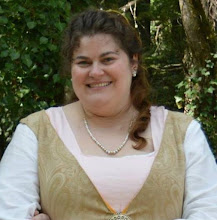Let's start off with a little education. There's many types of veils, many different lengths, embellishments, and characters.
Veil Length
There's many different lengths you can choose from with your veil, and they are traditionally decided by the location of your wedding. Your smallest veil is the birdcage veil (see my previous post). This veil just hugs your face, generally no longer than mid-neck.
The fly-away veil is the next longest. This veil brushes about the shoulders, and traditionally is a bit poofy in the back, like a bustle. (Bustle as in early 1900's bustle, not what today's bridal salons refer to).
Next is the elbow length veil. This is one of the big popular lengths. It's easy to manage for today's bride, and is just enough veil to be a presence without being it's own major piece in the bridal outfit.
After that is the finger-tip veil. The second most popular length. Again, easy to manage, but a little more formal.
Then we get into some serious length. The next veil on our length-based tour is the ballerina veil. These veils cover any range from the knee to the ankle. They get into the formal arena, without demanding floor space on the aisle.
Last, is the cathedral-length veil. These veils demand their own attention, trailing behind you from any range of length you want - just a couple short feet to dozens of yards, as seen by many a fairy-tale princess. These veils demand use in a very formal setting, traditionally in a large cathedral church or major synagogue, and a couple cute little girls helping you through doorways. Think Princess Diana's whopping 25 foot veil. These veils make for incredibly dramatic photographs, and trust me - that baby's coming off before you take one step into the reception.

Princess Diana's dress and veil, from the back. The scalloped lace is her veil.
Parts of the Veil
Parts? Yep, the veil has more to it than just length. The veil is traditionally made up of two parts, the blusher, and the back (known just as the veil). Not all veils sold in bridal salons are two-part veils including the back and blusher. Many salons today make an extra buck selling a basic blusher as a separate piece. The blusher is that pretty bit covering your face that your husband lifts in order to give you your "you may now kiss the bride" kiss. A definite must-have for romantics! The blusher can range from just below the chin, to just above the waist (so not to get in the way of the flowers). Though they're uber romantic, they aren't required!
Other popular types of veils are multi-tiered. These tiers are just adding to the look of your veil. Styles with multiple tiers can be used in combination with different lengths. Many cathedral gowns are three-tiered with elbow and fingertip lengths.
Veil Styles
Once you've chosen your veil length, you need to choose your style. There's lots of choices out there. First, there's the raw edge veil - just a simple cut tulle, no stitches or embellishments of any kind. Very bold. Next is the simple-stitch veil. The edges are just rolled and stitched, giving a simple, finished look. Then, we get into it. You can get ribbon-edged veils - ribbons of a variety of width, color, or design can be stitched on the edges of the veil. You can also get lace matching your dress to trim the tulle.
More popular right now are beaded veils. A separate strip of tulle, generally with smaller spaces, is covered with beads, or have a beaded design sown on. This strip is then sewn onto the veil around the edges. I must say, when I was trying on my gown last week, I saw a beaded-edge veil that matched my dress perfectly! Yes, I bought it. (Pictures soon)
Another veil style is the mantilla lace veil. Instead of using tulle for the veil body, the entire veil is made of lace. These veils traditionally cover the top of the head and frame the face; no blusher. Very beautiful, and the kind of veil that became popular in Spain and was huge in the 1920's.
My last bit of advice for you - make sure your veil fits your gown and your ceremony venue. Your veil should accent your gown, and enhance your look, not dominate or take-away from people looking at your glowing face. Above all, make sure you love it - it's part of your special day and is worth the time it takes the find the right one.

Mantilla veils, a beautiful way to frame the bride's face.
Happy planning!
Rebekah Ross
Weddings & Events


